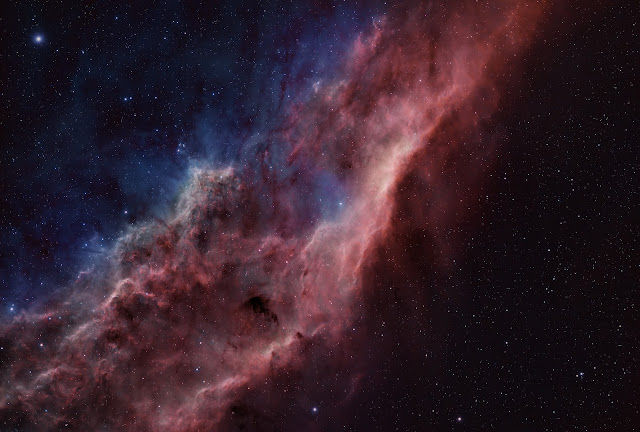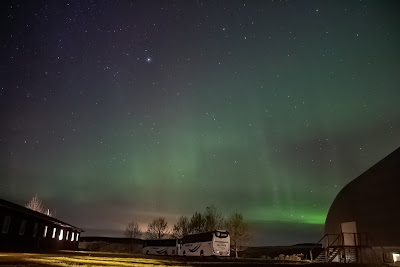Thursday 27 October 2022
Iceland Aurora
The aurora (the northern and southern lights) is the most wonderous and beautiful natural phenomenon that exist, this incredible light show caused by charged particles accelerated into our upper atmosphere from the Sun, this varies in strength depending on the Sun’s activity at the time.
A “solar wind” ejected from the Sun interacts with the Earth’s magnetic field, injecting it with energy and setting up a cycle that catapults electrons into the Earth’s atmosphere at the poles, where they collide with oxygen (green) and nitrogen (red) and cause them to release light—the aurora.
For most if not all us astronomers it is on top their bucket list to see a proper light show. Having seen the Aurora a few times before twice from our village in Norfolk and on a flight over the Faroe Islands I was hoping to be treated to something more than I had ever seen before.
My images below were captured last week 21th & 22th October on a trip to Iceland with the school.
We arrived at our location Hvolsvöllur on the south of the island about 2 hours from Reykjavík, late on the Friday to a dark clear sky. We ensured all those we in charge of were settled and I took a look outside. Almost immediately I was treated to, well for me the, greatest show on earth. I had set the camera up in the top car park away from the building’s lights and set it to record several hundred frames, I learned later that I had accidentally set it to record just 5. I had kicked myself a few times for this since but what I saw in the course of an hour and a half was just spectacular and made up for lack of first night photos.
The sky danced for what seemed forever with bright green light. Arcs appearing and fading every few seconds stretching for us from the North East to almost due South. curtains of Colour shimmered and changed shape before my eyes in a cosmic ballet across the sky. Rays of green reached to the heavens and for about 10 minutes we saw a complete auroral oval. I know a full aurora oval can only be seen from space, but what we saw like a huge green onion ring (very strange). Everything I had wished and hoped for was on display that night.
The second night cleared later in the night and upon returning at 2.30 in the morning I could again see colours in the darkest sky I have ever seen. There was some residual cloud to the West that was receding slowly but even this was backlit by a beautiful green light. Not anything like as vivid or strong as the previous night but still more impressive than the faint glows I have seen before.
Unfortunately, nights 3 & 4 were cloud filled so I left this beautiful island with what was a definite tick on that bucket list.
Sunday 16 October 2022
Dark Shark Nebula
This is my first attempt at capturing a dark nebula, and the Dark Shark or Howling Wolf as it is sometimes called became my target of choice because of it's beautiful variation of colored stars and it's uncanny resemblance to a hungry shark. Known to be an incredibly difficult object to image I was needing moonless skies. This was imaged over 2 nights with a total intergration time of 7.5 hours through Red, Green & Blue filters
This image shows the Dark Shark, a complex of several objects in Cepheus, located around 650 light years from us, and about 15 light years from snout to tail. The brownish portion is part of a large molecular cloud thought to be glowing dust powered by high-energy starlight. LDN 1235 is the dark spot in the shark’s head. vdB (Van den Bergh catalogue) 149 and 150 are the two blue reflection nebulae at the top and bottom of the shark’s neck. Both these beautiful reflection nebula shine with the color of very hot B8IV stars within these parts of the nebula.
Imaging details
* Oct 2nd / 15th 2022
* Norfolk, UK (Bortle 6)
* Telescope: Skywatcher Esprit ED100
* Camera: ZWO ASI 2600MM-PRO
* Filter: ZWO RGB
* Mount: Skywatcher EQ6R Pro
* Guide: Altair 60mm; ZWO ASI 120MM Mini
* Control: ASIAIPRo, ZWO EAF
* Software: PixInsight, Photoshop
* 50 x 180 seconds RGB Total
integration time:7.5 hours
Saturday 8 October 2022
A lobster and a bubble
Oh the weather is a fickle thing, yes the nights are drawing in seriously now but so has the cloud too. In a rare few evenings of clear skies I have started a new project.
A previous effort a couple of years ago for this target was a bit of a disappointment. I cannot quite remember but I think the project was unfinished so time to have another go. I have managed to create a lovely framing of the Lobster Claw with the Bubble nebula for this image. Night 1 was a 3h55m aquasition of Ha data. A quick process has revealed some lovely clean data.
Night 2 at the time of writing has been a little hit and miss with some high fast moving cloud, quickly clearing and returning some great guiding numbers again. This too is without any PEC training on the mount and I would love to get these numbers more consistent and will have a look at training over the weekend. I am hoping for 6 plus hours of Oiii so looks like a 4.00am finish if the clouds hold off, forecast now looking a good deal better. 1hr 15 so far.
Managed an exact 6 hours or 72 x 5 minute sub frames.
Night 3 was again a wonderful night and managed 4 hours with 48 z 5 minute sub frames.
Pixinsight process
Background extraction
Deconvolution
Noise reduction
Stretch to non linear
Pixel Maths combine channels
Curves
ACDNR
Local Histogram equalisation
Dark structure enhance
Final curves
Star reduction
I love the starless image created just before final star reduction.
Final Image
I have also in recent weeks completed a complete new set of calibration frames. As per the image above it looks like a great set and a relief. As I had a few issues with flats a few months ago so a new set needed doing. Pixinsight too has also seen some updates and has updated it's WBPP (weighted batch pre processing script) and it worked flawlessly with the new calibration set. I am really starting to enjoy using it now, still a complete novice and relying on tutorials but the results speak volumes. I am sure there are plenty of die hard fans who want to run all the calibration manually, but there are plenty of trusted you tubers and of course imagers like Adam Block who are increasinly confident that it is doing everything in the background a a full manual run. Like I said I am far from competent with the programme so will enjoy and take all the help I can get.
I along with my family are suffering from Covid. For us all it has been a struggle, having escaped it over the last 2 years it has caught up with us all. On the mend now but has been a real struggle to breath and a cough so bad it made my throat bleed. As I said thank god we are all on the mend now.
Subscribe to:
Posts (Atom)
California Nebula
NGC1499 The California Nebula. Discovered in 1889 The California Nebula is an emission nebula in the constellation of Perseus, currently v...

-
Object: M45Type: Open Cluster Distance: 380Light Years (Approx) Constellation: Taurus Date : 27th October 08 Equipment: William Optics M...
-
Without doubt the finest of globular clusters visible in the northern hemisphere. Located outside the plane of our galaxy and some 25,000 li...









































